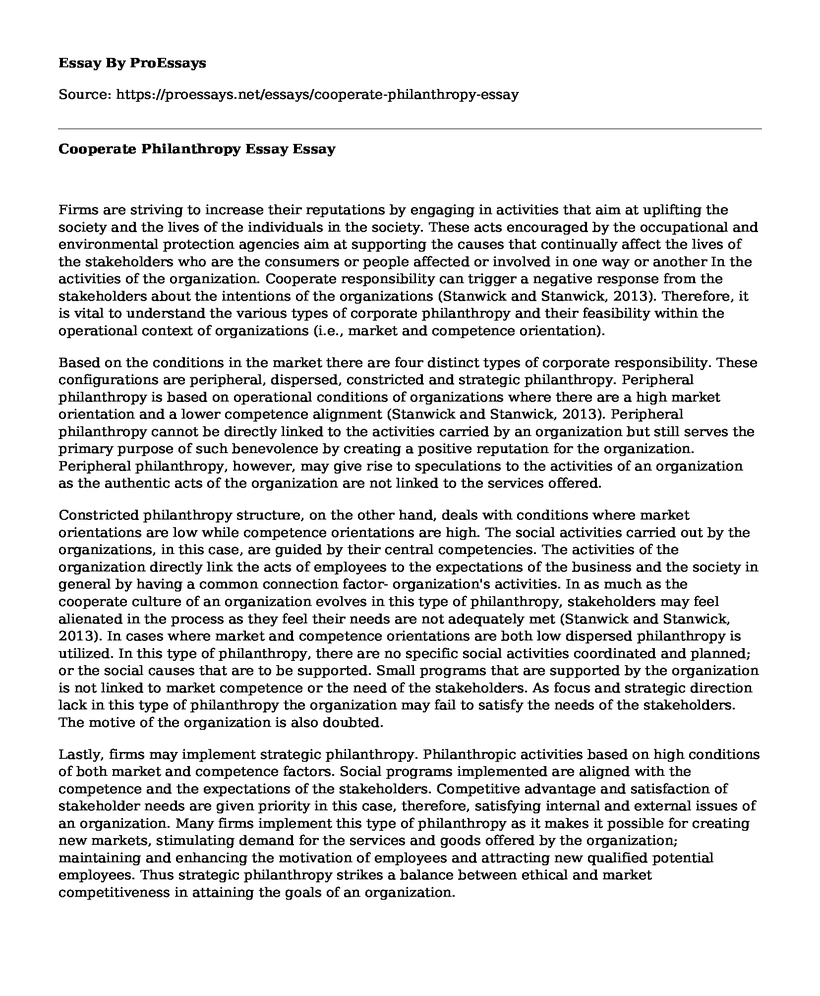Firms are striving to increase their reputations by engaging in activities that aim at uplifting the society and the lives of the individuals in the society. These acts encouraged by the occupational and environmental protection agencies aim at supporting the causes that continually affect the lives of the stakeholders who are the consumers or people affected or involved in one way or another In the activities of the organization. Cooperate responsibility can trigger a negative response from the stakeholders about the intentions of the organizations (Stanwick and Stanwick, 2013). Therefore, it is vital to understand the various types of corporate philanthropy and their feasibility within the operational context of organizations (i.e., market and competence orientation).
Based on the conditions in the market there are four distinct types of corporate responsibility. These configurations are peripheral, dispersed, constricted and strategic philanthropy. Peripheral philanthropy is based on operational conditions of organizations where there are a high market orientation and a lower competence alignment (Stanwick and Stanwick, 2013). Peripheral philanthropy cannot be directly linked to the activities carried by an organization but still serves the primary purpose of such benevolence by creating a positive reputation for the organization. Peripheral philanthropy, however, may give rise to speculations to the activities of an organization as the authentic acts of the organization are not linked to the services offered.
Constricted philanthropy structure, on the other hand, deals with conditions where market orientations are low while competence orientations are high. The social activities carried out by the organizations, in this case, are guided by their central competencies. The activities of the organization directly link the acts of employees to the expectations of the business and the society in general by having a common connection factor- organization's activities. In as much as the cooperate culture of an organization evolves in this type of philanthropy, stakeholders may feel alienated in the process as they feel their needs are not adequately met (Stanwick and Stanwick, 2013). In cases where market and competence orientations are both low dispersed philanthropy is utilized. In this type of philanthropy, there are no specific social activities coordinated and planned; or the social causes that are to be supported. Small programs that are supported by the organization is not linked to market competence or the need of the stakeholders. As focus and strategic direction lack in this type of philanthropy the organization may fail to satisfy the needs of the stakeholders. The motive of the organization is also doubted.
Lastly, firms may implement strategic philanthropy. Philanthropic activities based on high conditions of both market and competence factors. Social programs implemented are aligned with the competence and the expectations of the stakeholders. Competitive advantage and satisfaction of stakeholder needs are given priority in this case, therefore, satisfying internal and external issues of an organization. Many firms implement this type of philanthropy as it makes it possible for creating new markets, stimulating demand for the services and goods offered by the organization; maintaining and enhancing the motivation of employees and attracting new qualified potential employees. Thus strategic philanthropy strikes a balance between ethical and market competitiveness in attaining the goals of an organization.
Conclusion
Although cooperate philanthropy is one of the rising and highly debated acts by organizations, the failure of an organization to select the best strategy may fail to create the significant impact anticipated. Therefore determining the right condition of market and competence orientation determines the applicability of philanthropic strategy applied by an organization. An organization should also be able to prepare plans aimed at tackling possible challenges while addressing the expected benefits by the stakeholders while implementing a specific philanthropic strategy. Additionally, implementing various types of corporate responsibility strategies can also help in minimizing the weaknesses of one approach with the strength of the other. The latter further helps in adapting to the dynamic organizational environment.
References
Stanwick, P., & Stanwick, S. D. (2013). Understanding business ethics. Sage.
Cite this page
Cooperate Philanthropy Essay. (2022, Jun 19). Retrieved from https://proessays.net/essays/cooperate-philanthropy-essay
If you are the original author of this essay and no longer wish to have it published on the ProEssays website, please click below to request its removal:
- Organizational Systems and Structural Leaderships: Root Cause Analysis
- The Matrix Between Descartes and Plato - Compare and Contrast Essay Sample
- Personal Integrity and Business Success: Business Ethics Essay
- Essay Sample on Positive Aspects of the Memo about Leadership
- Banker's Acceptance - Essay Sample
- Essay Sample on Explaining the Enduring Resonance of the Hart-Fuller Debate
- Essay Sample on Organizational Change: Driving Improvement and Efficiency







